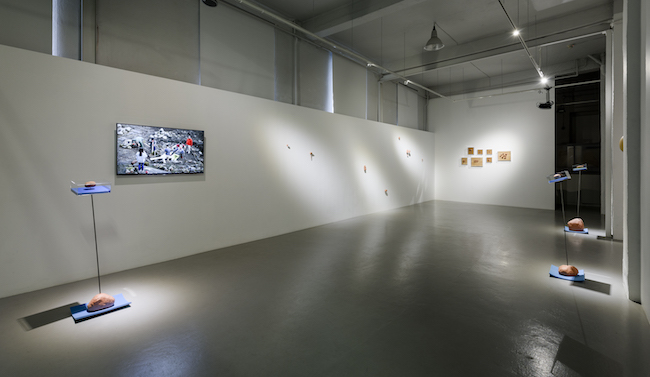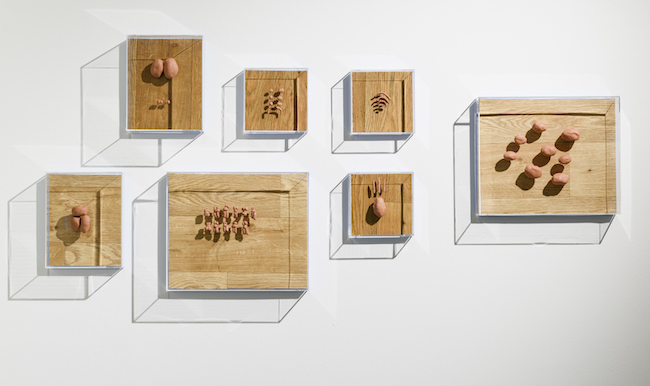
A hole in the fence
Flo Kasearu’s exhibition Holes at the Temnikova & Kasela gallery in Tallinn
16/07/2018
Is it worth going to Tallinn to see a hole in a fence? It is – if it’s part of an exhibition by the clever Estonian artist Flo Kasearu (ongoing through July 28 at Tallinn’s most internationally well-known gallery).
Although the show’s title has been translated into English as Holes, in the accompanying text it is explained that the Estonian title, Aia auk, can mean either ‘a hole in the fence’ or ‘a hole in the garden’. In order to fully comprehend the exhibition, one should be aware of the fact that since 2013 Kasearu has made her house and yard, which really are surrounded by a fence, into a site of perpetual creative expression. So as not to needlessly reiterate the long story behind this wooden house in the Tallinn suburb of Pelgulinn that has become the museum/home/art project of Flo Kasearu, please take a look at the Arterritory article on it from 2015.

Flo Kasearu’s exhibition Holes. Installation view
Kasearu’s latest show is not so much about what the museum-home is in itself, but more about its newest additions (albeit they are not all that new anymore – one of the two unpretentious videos is from 2014, the other from 2016/2018). If you haven’t been closely following the artist up to this point, then everything in the exhibition will seem fresh as can be – especially the sharpness of her ideas and her ability to turn commonplace situations into generalised themes.
Everyone who has ever lived in the countryside or a small town is familiar with the fences that surround every little plot of land, yard or house. This fence requires constant care from its owners: it serves as protection from strangers and thieves; it is seen by neighbours and passersby on a daily basis; and it requires a significant amount of maintenance since it spans the length of the property and, unless it is made of extremely expensive wrought iron, is steadily being worn down by the elements. Paint peels, boards warp, and posts rot...it’s almost more trouble than it’s worth. Flo Kasearu has experienced this same problem in the form of an unsightly hole that has appeared in her fence in a corner of the yard containing some old apple trees. It’s unlikely to be under threat of a prowler sneaking in through it, but it doesn’t look good, either. However, it is precisely in this spot that the artwork emerges. Instead of paying a handyman ten euros to nail some new boards over the hole, the homeowner, being an artist, has decided to do something much more creative. Making use of her connections at the Zachęta National Gallery of Art in Warsaw, one of the most prestigious art institutions in eastern Europe (and let’s not forget that Kasearu is herself the director of a respectable institution – her own eponymous museum!), Kasearu has come up with a international solution to dealing with the hole in the fence. Specifically, the artist has arranged for a security guard from the Polish gallery to come work in Tallinn for a time; all of the necessary financing and paperwork has been done through the proper official channels.

Flo Kasearu’s exhibition Holes. Installation view
In the approximately ten-minute-long video, nothing much happens. We see the yard with a hole in the fence, next to which stands a respectable-looking gentlemen in a dark suit – he is guarding. And he does what security guards at all art institutions do: looks to the left and the right, makes sure that nothing untoward takes place, and is bored out of his mind. Occasionally he munches on one of the apples that have fallen to the ground and which no one has thought to come to steal. The art continues in my mind as I wonder: damn it, how has this artist managed to so effortlessly react to so many of the questions and issues that contemporary art curators rehash again and again in their exhibitions, talks and articles? The over-institutionalisation of art; the aspects of international cooperation and the need to break down barriers, both literally and figuratively, between both nations and people. Not to mention the subject of debate currently on the tongues of politicians throughout Europe: to open our doors to guest workers or not? And she’s carried it out so intimately, without any cliches or pathos – indeed, with warm humor...alright, with a bit of biting satire as well!

Flo Kasearu’s exhibition Holes. Installation view
The other video work covers the same subject but is much more dynamic. Kasearu invited over landscape designers from Korea (whom she met at an international art biennial in Guangzhou, of course) to beautify the yard. The landscapers took their job quite seriously and, with the aid of some local workers, constructed throughout Kasearu’s yard a number of human-sized artificial mounds which were then seeded with grass. It wasn’t easy work: earth had to be hauled, rocks were rolled and heaved; it appears that something like a rock garden or pond is also being made. Side by side, Koreans and Estonians worked hard and long. And in the end, the grassy mounds aren’t all that easy to mow!

Flo Kasearu’s exhibition Holes. Installation view
There were a few objects in the exhibition which I didn’t quite understand. Were they potatoes (a vegetable introduced to Europe as a metaphor for guest workers?) or rocks that just look like potatoes? And the various roots framed in glass and mounted on the walls – the artist’s ironic take on contemporary art in which all sorts of junk is raised to the level of ‘a work of art’?
It wasn’t for naught that I mentioned that some of the art is created in the mind of the viewer (that is, if the viewer has at least a passing knowledge of the context of contemporary art). For it turns out that Flo Kasearu’s museum-house, much like a hen that lays golden eggs, churns out thoughts on everything – such as how to link the internationalism of contemporary art to a specific place (a place that is not Berlin, Brussels or London, that is). Kasearu’s answer is to employ a long-term strategy: a couple of years ago she was asked if the project with her own house hadn’t played itself out by now; Kasearu replied that it is worth continuing because the house keeps providing new possibilities for being creative. It turns out that living on the outskirts of Tallinn offers as much material for contemporary art as constant travelling, which, being an internationally sought-after artist, she obviously does as well. The decision to take on the world in your home, to open the door to the problems of the day, has been the right one. The longer a project lasts, the more important and unique it becomes; it enriches the rush of the moment with a dimension of longevity, injects carelessness with robustness, and merges the cosmopolitan with the Estonian. Project culture augments geographical culture, and life augments art – which is a good thing for both.